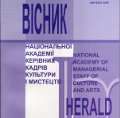«КУПАЛЬСЬКА СПРАВА» МИКОЛИ ЛИСЕНКА: КОНЦЕРТНО-ХОРОВЕ ВТІЛЕННЯ НАРОДНОГО ОБРЯДУ
Mykola Lysenko’s «Kupalo Case»: Concert and Choral Implementation of Folk Rite
Author(s): Natalia Tadeyivna SynkevychSubject(s): Customs / Folklore, Music, Culture and social structure , Sociology of Culture, Sociology of Art, History of Art
Published by: Національна академія керівних кадрів культури і мистецтв
Keywords: composer; folklore; calendar ritual; Kupalo; choral texture; piano part;
Summary/Abstract: The purpose of the article is to identify the peculiarities of concert and choral implementation of the cycle of Kupalo songs in the interpretation by Mykola Lysenko. Research methodology is based on the synthesis of the folkloristic and art-studying approaches, which enable us to prove the fruitfulness of complementarity of various types of the artist’s creative activities. Cultural-historical, system-analytical and didactical methods are used in order to study the ways of concert reinterpretation of the folk-rite performance presented by a mixed choir with piano accompaniment, as well as to generalise the cognitive and spiritual values of that type of the repertoire. The scientific novelty of the research lies in the first analysis of the conformity of the composer’s idea and its implementation through the selected set of the expressive means to the content and essence of the ancient ritual authenticity on the example of a specific choral work. Conclusions. The ritual-choral cycle «The Kupalo Case» is a synthesis of folk archaism and innovative ways of concert enrichment of music language. Three folk songs under the common title are united by a dramatic idea, based on folk philosophy of the summer fest of Kupalo, its symbolism of purification through fire, water, and pairing of youth. The general cyclicality of the composition is cemented by an optimistic idea of glorifying the life. The piano part plays an important formative role, makes the verbal text more detailed and enriches the choral score in figurative and meaningful aspects. The harmonious language of the work contributes to the preservation of the archaic coloration. The general homophonic and harmonic texture sometimes reveals the signs of polyphonic layers, differentiated by male and female voices. Their layering reflects the contrast of timbres, registers, and character of melodies. As a result a peculiar style of choral theatricalisation is achieved, which coincides with the syncretism of the primary calendar-ritual performance.
Journal: Вісник Національної академії керівних кадрів культури і мистецтв
- Issue Year: 2023
- Issue No: 1
- Page Range: 276-280
- Page Count: 5
- Language: Ukrainian

